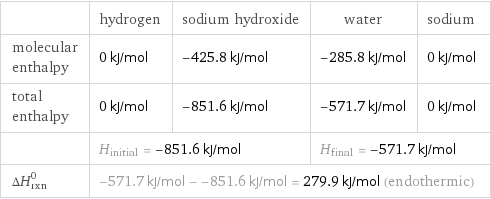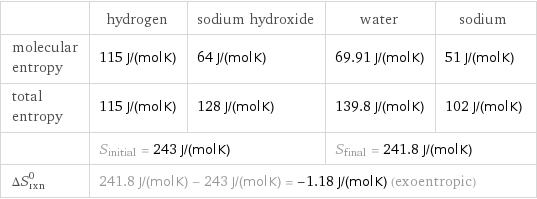Input interpretation

H_2 hydrogen + NaOH sodium hydroxide ⟶ H_2O water + Na sodium
Balanced equation

Balance the chemical equation algebraically: H_2 + NaOH ⟶ H_2O + Na Add stoichiometric coefficients, c_i, to the reactants and products: c_1 H_2 + c_2 NaOH ⟶ c_3 H_2O + c_4 Na Set the number of atoms in the reactants equal to the number of atoms in the products for H, Na and O: H: | 2 c_1 + c_2 = 2 c_3 Na: | c_2 = c_4 O: | c_2 = c_3 Since the coefficients are relative quantities and underdetermined, choose a coefficient to set arbitrarily. To keep the coefficients small, the arbitrary value is ordinarily one. For instance, set c_1 = 1 and solve the system of equations for the remaining coefficients: c_1 = 1 c_2 = 2 c_3 = 2 c_4 = 2 Substitute the coefficients into the chemical reaction to obtain the balanced equation: Answer: | | H_2 + 2 NaOH ⟶ 2 H_2O + 2 Na
Structures

+ ⟶ +
Names

hydrogen + sodium hydroxide ⟶ water + sodium
Reaction thermodynamics
Enthalpy

| hydrogen | sodium hydroxide | water | sodium molecular enthalpy | 0 kJ/mol | -425.8 kJ/mol | -285.8 kJ/mol | 0 kJ/mol total enthalpy | 0 kJ/mol | -851.6 kJ/mol | -571.7 kJ/mol | 0 kJ/mol | H_initial = -851.6 kJ/mol | | H_final = -571.7 kJ/mol | ΔH_rxn^0 | -571.7 kJ/mol - -851.6 kJ/mol = 279.9 kJ/mol (endothermic) | | |
Entropy

| hydrogen | sodium hydroxide | water | sodium molecular entropy | 115 J/(mol K) | 64 J/(mol K) | 69.91 J/(mol K) | 51 J/(mol K) total entropy | 115 J/(mol K) | 128 J/(mol K) | 139.8 J/(mol K) | 102 J/(mol K) | S_initial = 243 J/(mol K) | | S_final = 241.8 J/(mol K) | ΔS_rxn^0 | 241.8 J/(mol K) - 243 J/(mol K) = -1.18 J/(mol K) (exoentropic) | | |
Equilibrium constant
![Construct the equilibrium constant, K, expression for: H_2 + NaOH ⟶ H_2O + Na Plan: • Balance the chemical equation. • Determine the stoichiometric numbers. • Assemble the activity expression for each chemical species. • Use the activity expressions to build the equilibrium constant expression. Write the balanced chemical equation: H_2 + 2 NaOH ⟶ 2 H_2O + 2 Na Assign stoichiometric numbers, ν_i, using the stoichiometric coefficients, c_i, from the balanced chemical equation in the following manner: ν_i = -c_i for reactants and ν_i = c_i for products: chemical species | c_i | ν_i H_2 | 1 | -1 NaOH | 2 | -2 H_2O | 2 | 2 Na | 2 | 2 Assemble the activity expressions accounting for the state of matter and ν_i: chemical species | c_i | ν_i | activity expression H_2 | 1 | -1 | ([H2])^(-1) NaOH | 2 | -2 | ([NaOH])^(-2) H_2O | 2 | 2 | ([H2O])^2 Na | 2 | 2 | ([Na])^2 The equilibrium constant symbol in the concentration basis is: K_c Mulitply the activity expressions to arrive at the K_c expression: Answer: | | K_c = ([H2])^(-1) ([NaOH])^(-2) ([H2O])^2 ([Na])^2 = (([H2O])^2 ([Na])^2)/([H2] ([NaOH])^2)](../image_source/085208f0553a2b183665e8f6c203a022.png)
Construct the equilibrium constant, K, expression for: H_2 + NaOH ⟶ H_2O + Na Plan: • Balance the chemical equation. • Determine the stoichiometric numbers. • Assemble the activity expression for each chemical species. • Use the activity expressions to build the equilibrium constant expression. Write the balanced chemical equation: H_2 + 2 NaOH ⟶ 2 H_2O + 2 Na Assign stoichiometric numbers, ν_i, using the stoichiometric coefficients, c_i, from the balanced chemical equation in the following manner: ν_i = -c_i for reactants and ν_i = c_i for products: chemical species | c_i | ν_i H_2 | 1 | -1 NaOH | 2 | -2 H_2O | 2 | 2 Na | 2 | 2 Assemble the activity expressions accounting for the state of matter and ν_i: chemical species | c_i | ν_i | activity expression H_2 | 1 | -1 | ([H2])^(-1) NaOH | 2 | -2 | ([NaOH])^(-2) H_2O | 2 | 2 | ([H2O])^2 Na | 2 | 2 | ([Na])^2 The equilibrium constant symbol in the concentration basis is: K_c Mulitply the activity expressions to arrive at the K_c expression: Answer: | | K_c = ([H2])^(-1) ([NaOH])^(-2) ([H2O])^2 ([Na])^2 = (([H2O])^2 ([Na])^2)/([H2] ([NaOH])^2)
Rate of reaction
![Construct the rate of reaction expression for: H_2 + NaOH ⟶ H_2O + Na Plan: • Balance the chemical equation. • Determine the stoichiometric numbers. • Assemble the rate term for each chemical species. • Write the rate of reaction expression. Write the balanced chemical equation: H_2 + 2 NaOH ⟶ 2 H_2O + 2 Na Assign stoichiometric numbers, ν_i, using the stoichiometric coefficients, c_i, from the balanced chemical equation in the following manner: ν_i = -c_i for reactants and ν_i = c_i for products: chemical species | c_i | ν_i H_2 | 1 | -1 NaOH | 2 | -2 H_2O | 2 | 2 Na | 2 | 2 The rate term for each chemical species, B_i, is 1/ν_i(Δ[B_i])/(Δt) where [B_i] is the amount concentration and t is time: chemical species | c_i | ν_i | rate term H_2 | 1 | -1 | -(Δ[H2])/(Δt) NaOH | 2 | -2 | -1/2 (Δ[NaOH])/(Δt) H_2O | 2 | 2 | 1/2 (Δ[H2O])/(Δt) Na | 2 | 2 | 1/2 (Δ[Na])/(Δt) (for infinitesimal rate of change, replace Δ with d) Set the rate terms equal to each other to arrive at the rate expression: Answer: | | rate = -(Δ[H2])/(Δt) = -1/2 (Δ[NaOH])/(Δt) = 1/2 (Δ[H2O])/(Δt) = 1/2 (Δ[Na])/(Δt) (assuming constant volume and no accumulation of intermediates or side products)](../image_source/b6be2b5c9b8993bddabed5725ba566e5.png)
Construct the rate of reaction expression for: H_2 + NaOH ⟶ H_2O + Na Plan: • Balance the chemical equation. • Determine the stoichiometric numbers. • Assemble the rate term for each chemical species. • Write the rate of reaction expression. Write the balanced chemical equation: H_2 + 2 NaOH ⟶ 2 H_2O + 2 Na Assign stoichiometric numbers, ν_i, using the stoichiometric coefficients, c_i, from the balanced chemical equation in the following manner: ν_i = -c_i for reactants and ν_i = c_i for products: chemical species | c_i | ν_i H_2 | 1 | -1 NaOH | 2 | -2 H_2O | 2 | 2 Na | 2 | 2 The rate term for each chemical species, B_i, is 1/ν_i(Δ[B_i])/(Δt) where [B_i] is the amount concentration and t is time: chemical species | c_i | ν_i | rate term H_2 | 1 | -1 | -(Δ[H2])/(Δt) NaOH | 2 | -2 | -1/2 (Δ[NaOH])/(Δt) H_2O | 2 | 2 | 1/2 (Δ[H2O])/(Δt) Na | 2 | 2 | 1/2 (Δ[Na])/(Δt) (for infinitesimal rate of change, replace Δ with d) Set the rate terms equal to each other to arrive at the rate expression: Answer: | | rate = -(Δ[H2])/(Δt) = -1/2 (Δ[NaOH])/(Δt) = 1/2 (Δ[H2O])/(Δt) = 1/2 (Δ[Na])/(Δt) (assuming constant volume and no accumulation of intermediates or side products)
Chemical names and formulas

| hydrogen | sodium hydroxide | water | sodium formula | H_2 | NaOH | H_2O | Na Hill formula | H_2 | HNaO | H_2O | Na name | hydrogen | sodium hydroxide | water | sodium IUPAC name | molecular hydrogen | sodium hydroxide | water | sodium